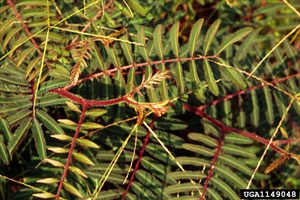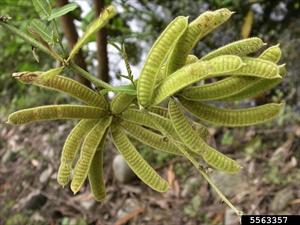Giant sensitive tree; it also known as giant mimosa, sensitive tree, or catclaw mimosa. CABI calls it giant sensitive plant, but that name is also given to Mimosa diplotricha.
Pacific Pests, Pathogens, Weeds & Pesticides - Online edition
Pacific Pests, Pathogens, Weeds & Pesticides
Giant sensitive tree (470)
Mimosa pigra. It is a member of the Fabaceae.
Widespread. Asia, Africa, North, South and Central America, the Caribbean, Oceania. It is recorded from Australia, Fiji, French Polynesia, New Caledonia, New Zealand, Papua New Guinea.
It is native to Mexico, Central America, tropical South America, and the Caribbean.
An invasive shrub forming dense impenetrable thickets: a weed of roadsides, waterways, drainage ditches, grass floodplains, swamps, seasonally flooded wetlands, lowland pastures and the edges of water bodies in wetter tropical and sub-tropical regions (Photo 1). Its invasiveness is due to its aggressive growth, ability to tolerate a range of soil types, and the production of large amounts of seed.
The shrub grows to about 2 m tall, but can be up to 6 m, with scattered thorns, 5-12 mm long, on the stems, branches and leaf stalks. Leaves, alternate along the stems, about 20-30 cm long, divided into 6-16 pairs of leaf-like segments (branchlets), each of which has a central midrib and up to 45 pairs of leaflets, 3-12 mm long and 0.5-2 mm wide (Photo 2). The leaflets fold together when touched or at night. Flowerheads, about 10-20 mm diameter, composed of about 100 individual pink or mauve flowers, each with eight prominent stamens (male parts), giving it a fluffy look (Photo 3). Every flowerhead produces 10-20 seed pods which are flat, 3-12 cm long and 7-14 mm wide, covered with rust-coloured bristles (Photo 4). Pods contains up to 25 seeds; when mature the pods break into 1-seeded pieces. Seeds, 4-6 mm long and 2-3 mm wide, are oblong, brown or olive-green (Photo 5).
Spread is by seeds - large trees can produce more than 200,000 seeds a year. The seeds float in floodwater, and become attached to machinery, vehicles and boats. They are also spread in the transportation of sand, on the fur of animals, and the clothes of humans. They can pass through the gut of animals undamaged. The bush has been considered an ornamental, and used in traditional medicines.
A weed of economic and environmental significance. It forms dense stands in the wetlands of northern Australia harming the productive, cultural and conservation values of native vegetation. It affects the livelihoods of pastoralists: it blocks access to livestock watering points, herding, and smothers and replaces grasslands, greatly reducing grazing capacity. More than 80,000 ha are said to be impacted. The giant sensitive tree also prevents the collection of bush foods. In Thailand, the weed blocks rice irrigation systems, reducing crop yield. In Malaysia, it is a problem in young oil palm plantations. And in Vietnam, it has invaded unique ecosystems in protected areas, threatening the biodiversity of seasonally inundated grasslands, and this has affected tourism.
The weed has been used for erosion control, as a fuel, a green manure, a cover crop, hedges, and also for medicinal purposes. It contains mimosine which is a purgative.
AUTHORS Grahame Jackson & Aradhana Deesh
Adapted from Giant sensitive tree (Mimosa pigra) (2018) Weeds of SE Qld and Northern NSW. Lucidcentral. (https://www.lucidcentral.org/editors-pick-animal-and-plant-identification-keys/key-to-weeds-of-se-qld-and-northern-nsw); and additional information from CABI (2019) Mimosa pigra (giant sensitive plant). Invasive Species Compendium. (https://www.cabi.org/isc/datasheet/34199); and Mimosa pigra L. (2011) Weeds Australia - profiles. Department of Agriculture, Water and the Environment. (https://profiles.ala.org.au/opus/weeds-australia/profile/Mimosa%20pigra); and from Thornhill A (2020) Mimosa pigra L. Giant sensitive plant. Council of Heads of Australasian Herbaria. Department of Sustainability, Environment, Water, Population and Communities. Australian Government. (https://profiles.ala.org.au/opus/weeds-australia/profile/Mimosa%20pigra). Photo 1 Amy Ferriter, State of Idaho, Bugwood.org.
Produced with support from the Australian Centre for International Agricultural Research under project HORT/2016/185: Responding to emerging pest and disease threats to horticulture in the Pacific islands, implemented by the University of Queensland, in association with the Pacific Community and Koronivia Research Station, Ministry of Agriculture, Fiji.








